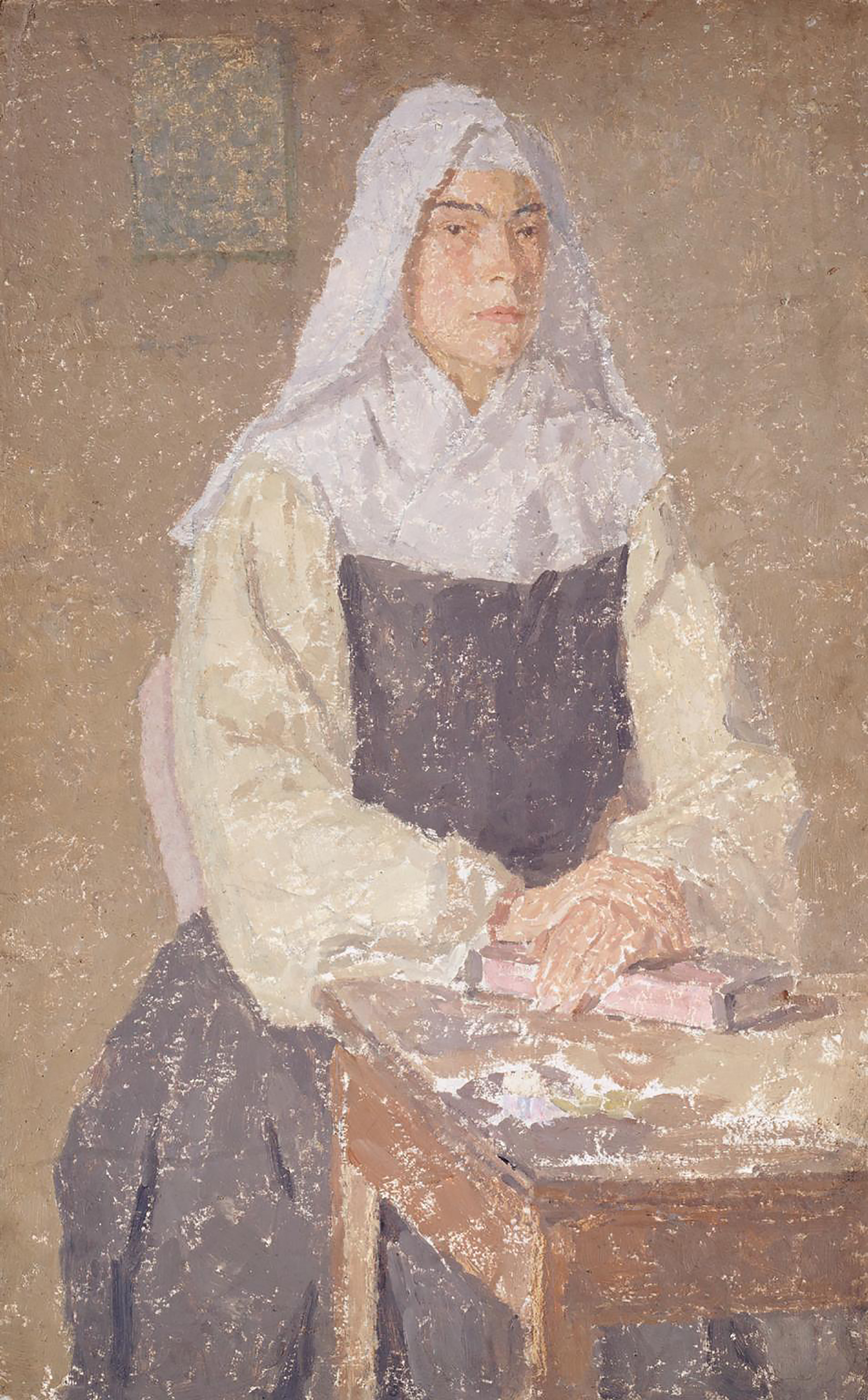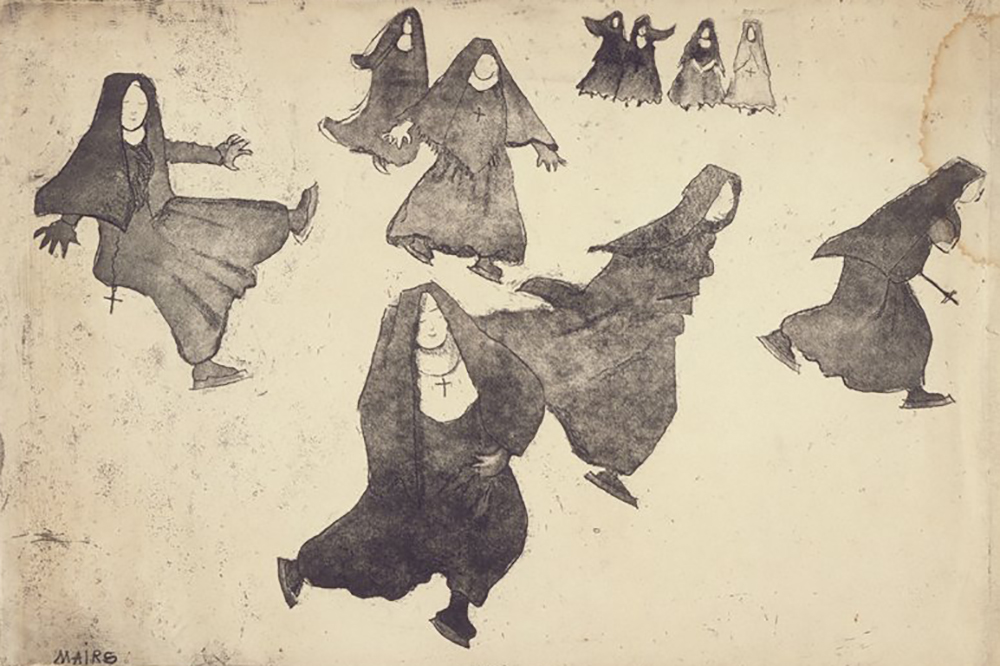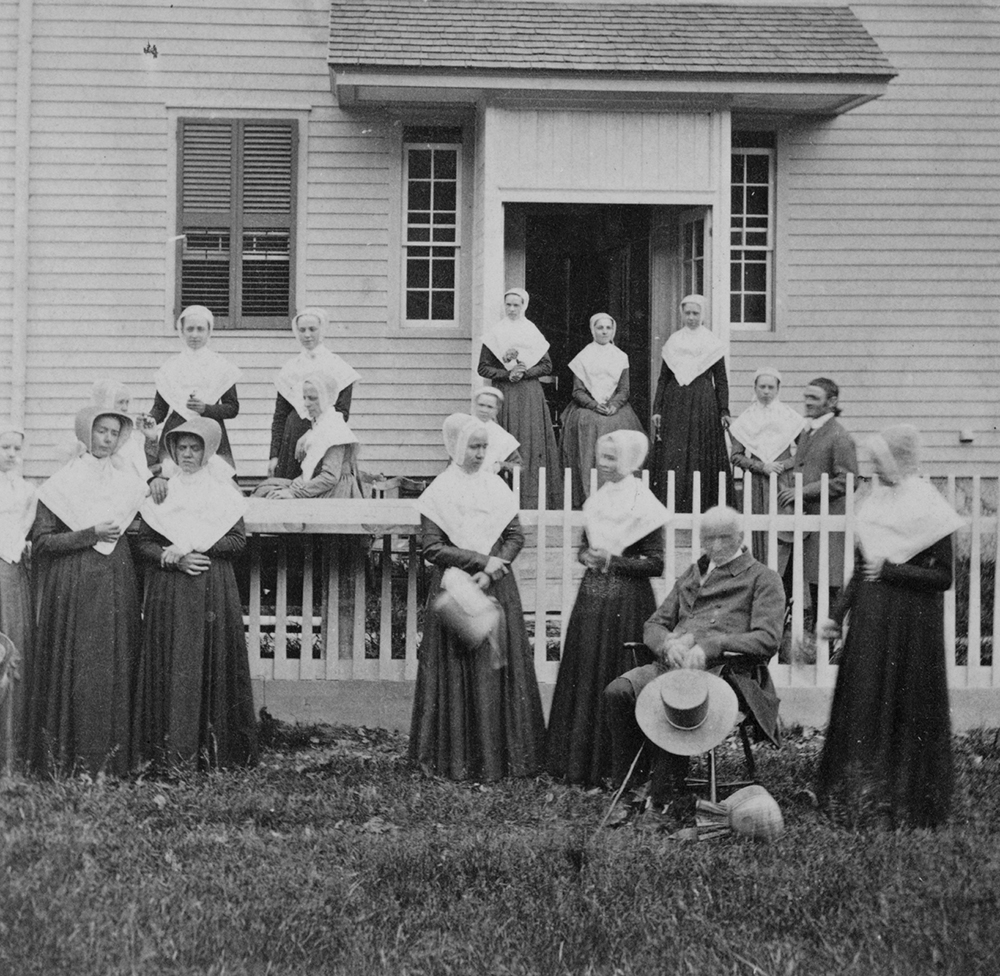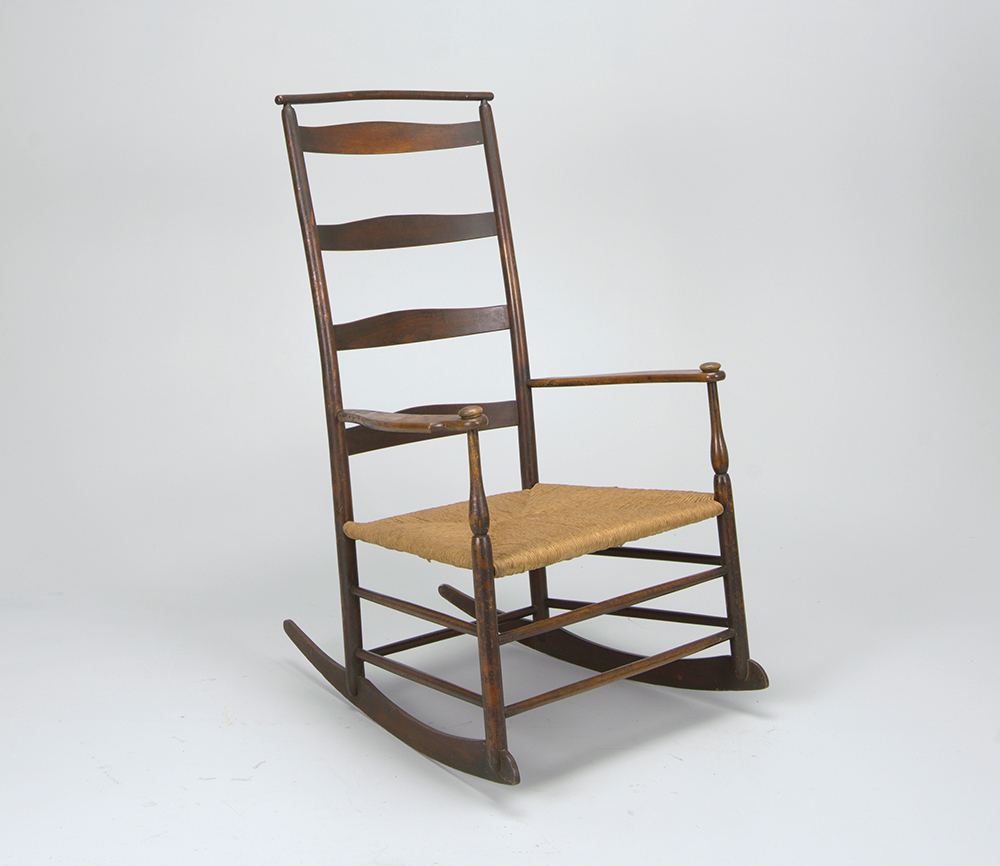
The Nun, by Gwen John, c. 1915. Photograph © Tate (CC-BY-NC-ND 3.0).
To be against sex in the nineteenth century was not only to challenge gender norms and sexual conventions but to propose a radical reorganization of society as nineteenth-century Americans knew it. Heterosexual sex was a linchpin of marriage, and by extension a linchpin of the family. Those who questioned the centrality of sex to human existence directly attacked the fundamental social conventions of their time. For Shaker and Catholic celibates, distance from one’s biological family could mean the creation of what gay humorist Armistead Maupin once termed “the logical family”—a community of people with shared values, or a family of choice. Families of choice have long been considered a cornerstone of queer culture. Prior to the legalization of same-sex marriage, these intentional families, networks of friends, lovers, and ex-lovers, were celebrated by queer scholars and activists.
The families of choice found within Shaker villages and Catholic religious communities provide important historical antecedents for understanding families of choice. Scholars within the fields of public policy and sociology have also recently pushed to decenter the nuclear family as the primary unit of study, recognizing that a great portion of our modern lives is spent outside family units, with friends, colleagues, and neighbors. Breaking away from families of origin and remaking them into families of choice were not incidental for Shaker and Catholic men and women, but should be understood as a deeply political act. The alternative structures of Shaker and monastic family life and the intimacies they created without sex built an explicit, nonnormative sexual culture in a society that rigidly presented heterosexual love and family as the only legitimate and legal option. The out-and-proud sexual abstinence of these groups also challenged dichotomies of public and private. Making their celibacy and sexual restraint an explicit aspect of group membership, rather than a privately held belief, allowed these subjects to create alternate institutions and family structures.
Groups that challenged sex and its role within the family sought more equitable gender relations and attacked men’s presumed ownership of women’s bodies. It is also important to note that within these remade and reformed families, abstinence from sex did not mean abstinence from love or affection.

Advocates of sexual restraint promoted a sexual identity based on abstinence and did so during a century that saw a dramatic increase in the number of never-married adults. During the colonial era, it was nearly unheard of for women especially not to marry. Men in some locales faced economic discrimination for remaining unwed in the form of a “bachelor tax.” The growth in opportunities for women to support themselves as teachers and for men to participate in the new managerial and industrial economy, far beyond parental influence, meant that in 1830 it was more possible to remain unmarried than ever before. Over the course of the century, the percentage of native-born never-married women would increase from 7.3 percent in 1830 to 10.9 percent in 1870. In New England these trends were dramatically more pronounced. In 1830, 14.6 percent of Massachusetts women never married; by 1870, the number had climbed to 22.6 percent, nearly double the national average.
Catholic sisters and priests created relationships outside those of the traditional family structure that were nevertheless meaningful and important. Though bonds between confessors and sisters or superiors and sisters often seem to have replicated a parent-child relationship (as evidenced by use of titles like “Father” and “Mother”), religious also connected across gender lines as colleagues and comrades. Such bonds were indeed emotionally, if not physically, intimate, and were perhaps right to spark the antebellum Protestant imagination. Eulalia Kelly, a Sister of Loretto, was sent to found a free school in rural Jefferson County, Arkansas, in 1840. By all appearances, Sister Eulalia enjoyed religious life. But she hated to be parted from her confessor, Father Timon, whom she had met as a young nun in Missouri. She explained in a letter, “To leave the house of my parents was, for me, a great sacrifice, but to be deprived of your counsel and advice, is one much greater. Maryland is long since forgotten by me, but the kindnesses I have received from you are not forgotten.” Sister Eulalia concluded wistfully, “I believe I would be very happy here could I see you, say only once a year,” though she knew the hundred-mile journey between frontier Arkansas and Timon’s post in Perrysville made even such a small wish unlikely to come true.
Shakers, too, formed intense lifelong bonds with each other. As both Catholic priests and nuns and Shaker sisters and brothers lived in sex-segregated environments, it is not at all surprising that many of these close friendships were with members of the same sex. As nineteenth-century culture itself cultivated what scholar Carroll Smith-Rosenberg called “a female world of love and ritual,” such friendships would not have been out of place in “the world.” In the autobiography written toward the end of his life, Issachar Bates saved his fondest remembrances for his missionary partner, Benjamin Youngs, not his wife or children, though they were Shakers, too. Bates and Youngs logged thousands of miles together preaching in the Old Northwest. “Little Benjamin” was Bates’ “beloved companion,” and though he admitted he learned something from all of those with whom he traveled, Benjamin Youngs was special: “I am persuaded that there never were any David’s & Jonathan’s hearts more closely knit together.”
Unlike Catholic communities that guarded against “particular friendships,” Shakers seem to have held close same-sex bonds in high esteem. At the age of seventy-five, the western Shaker societies arranged for this David and Jonathan pair to meet one last time before Issachar made his way back east to Mount Lebanon. “The people at Pleasant Hill were determined to see us both together once more in this world,” Bates recorded, so in August 1833 the two men made a joint farewell tour of Kentucky “and visited every family, Benjamin and Issachar together once more, like former times, which was a great satisfaction.” On September 6, 1833, they parted on the banks of the Ohio: “My beloved Elder Benjamin and others accompanied us across the river, and we then exchanged a few kisses, and bid, as I supposed, a last farewell.”

Contrary to what one might expect among Shakers, for whom opposite-sex attraction was both a taboo and a grave sin, there seems to have been an understanding that pure expressions of affection between members of the same sex were both necessary and desirable. In this regard, they again differ from the harsh regimes of the Catholic seminaries, whose rules strived to prevent any kind of intimacy, regardless of gender. When two brothers from Mount Lebanon were sent on a friendship tour of the western Shaker societies in 1834, their Ohio counterparts were glad to receive them. Yet they were dismayed that no sisters from the east accompanied them and expressed their displeasure to the central ministry at Mount Lebanon. The “poor sisters,” they reported, “looked so lonesome and wishful to be obliged to stand and see the brethren hugging, shaking hands, and even kissing without being suitably represented, so as to afford them a like opportunity was grievous to be borne, and indeed who can blame them for feeling this?” While brothers Rufus and Isaac did their best to include the sisters in conversation and were happy to visit the sisters’ workshops, because of the taboos around opposite-sex interaction in Shaker communities, the Shakers themselves knew it was not the same. The Ohioans strongly urged the ministry to send both brothers and sisters next time, adding, “We have open doors and inviting hearts.” Shakers may have interpreted same-sex bonds of affection as evidence for the divine love they aimed to share with all members.
Rather than the “fleshy” or selfish love that existed between husband and wife or parent and child, the love between spiritual partners like Issachar Bates and Benjamin Youngs appeared pure, platonic, and transcendent. Relationships like that between Bates and Youngs exemplified the Shakers’ spiritual ideal. Yet the sect also carved out spaces for emotional and spiritual intimacy between men and women within their communities. Shaker sisters and brothers routinely came together for conversation in a ritual known as the “union meeting,” which developed during the earliest years of the sect and continued throughout the nineteenth century.
In 1792 Father David Meacham conceived of a “Union of the Sexes,” which would benefit the society both spiritually and pragmatically. As each Shaker society was ordered into families, and separate male and female orders within each family, it was necessary to find a way for the male and female Shaker leadership to come together to discuss the spiritual and temporal needs of the community. Beyond that, it was Meacham’s opinion that if Shaker men and women “had not a spiritual union, they would have a carnal” one. The union meeting was his solution to this problem. Every Shaker was assigned a union-meeting partner of the opposite sex. They would meet regularly for conversation: according to a nineteenth-century history of the Shakers, sisters lined up opposite their assigned brothers no closer than “five feet apart” and took care “not to be too profuse, contracted, or particular in their freedom & union with the opposite sex.” In addition to engaging in conversation on “any familiar suitable subjects,” union-meeting partners were expected to fulfill gender-specific tasks for one another. So the female half of a union-meeting partnership mended the clothes of her assigned brother. The brother, in turn, aided his female meeting partner in any tasks she needed doing that required manual labor or craftsmanship.

The platonic affection and bonds developed between union meeting partners did not threaten the Shakers’ gospel of celibacy—they enhanced it. Union meetings allowed “for mutual comfort and protection” but were also seen as “a preventative against all disorderly and unchaste union.” The need for union meetings again points to the gendered and sexual assumptions that prevailed even under the Shakers’ regime of celibacy. Rather than have brothers sew or sisters make furniture (a premise that would have allowed for stricter separation between the sexes), they created an allowance for heterosocial if not heterosexual partnerships. That public union meetings between men and women would discourage any kind of private “unchaste union” again affirms that Shakers did not believe their celibacy was anything “natural.”
On the contrary, the need for union meetings show that the Shakers assumed that the sexes were naturally drawn to one another and would seek out illicit opportunities to interact if they were not provided them through official ministry-approved channels. Union-meeting partnerships were more than just a kind of “safety release valve” for heterosociality—they often created genuine loving, platonic attachments. One former Shaker at Watervliet recalled how occasionally “one brother sometimes eulogized a sister whom he thought to be the best cook, and who could make the best ‘Johnny cake.’ ” The types of furniture a Shaker brother might make for his female counterpart, such as a sewing desk or chair, were specifically tailored to the task at hand. These tools and objects, simple but well made, were crafted with a perfectionistic attention to detail that was an expression of the Shakers’ spirituality. Edward Deming Andrews and Faith Andrews wrote in Religion in Wood: A Book of Shaker Furniture that the “peculiar grace” of a Shaker chair stems from its maker’s belief “that an angel might come and sit on it.” Gifts of pie and furniture between union-meeting partners, and between Shaker sisters and brothers, should not be read as anything less than expressions of divine love in material form. The furniture, highly prized by collectors, remains, but unfortunately the pies and johnny cakes do not. Both the example of the union meetings and the loving friendship of Bates and Youngs demonstrate that embracing celibacy did not mean abandoning human affection and attachment altogether.
From Against Sex: Identities of Sexual Restraint in Early America by Kara M. French. Copyright © 2021 by the University of North Carolina Press. Used by permission of the publisher.
